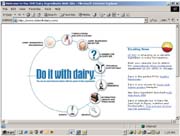
Cheese and other dairy products (e.g., butter, fluid milk, yogurt, sour cream, cream, dry milk, buttermilk) have been widely accepted and available to consumers as nutritious and highly palatable food choices in their own right for centuries. Consumers regularly are reminded of the versatility of these dairy foods during various eating occasions, such as meals or snacks.
Many consumers will continue to eat dairy foods as a mainstay of their diets. However, dairy foods also find their way into the diet as an ingredient in other food products. Consumer demands for convenience, the large number of meals eaten away from home and other changing consumer habits continue to fuel their interest in finding new ways in which dairy foods can be part of a healthy and enjoyable diet.

Dairy Foods as Dairy Ingredients
To meet such needs, food technologists and culinologists look for specialized and customized dairy foods and ingredients that can perform specific functions in food formulations. Food marketers look for these ingredients to provide real marketing advantages (e.g., taste, cost, nutrition/health, wholesome image, shelflife, mouthfeel) for their formulated foods. Further, such ingredients must consistently perform, from the laboratory benchtop to the challenges of high-speed, large-scale food production and, ultimately, to extended product distribution channels.Today's dairy product manufacturers are much more cognizant of the need to tailor their products to perform as an ingredient in other food systems. Fortunately for dairy manufacturers, they have a head start in regards to this task in that much already has been demanded of their products: a good shelflife; the ability to withstand thermal processing; the retention of desirable dairy flavors; a smooth, creamy mouthfeel; and the delivery of key nutrients.
For example, non-fat, dry milk manufacturers have known for years that milk powder has to be processed differently to supply a functional source of dairy solids to a cheese maker than to an ice cream manufacturer. The dairy industry also knows it must continue to evolve and deliver such products as customized ingredients for a diverse, demanding, and ever-changing food industry. The dairy ingredient sector also must assist food formulators in ingredient interactions, nutrient fortification, flavor compatibility, product stability and appropriate processing technologies.
In years past, some people viewed dairy ingredients such as whey protein concentrates (WPCs) as generic commodities with a standard composition, non-descript functionality and little processing or end-use considerations. Today, informed users of WPCs know differently. These products now are available with different nutritional profiles. They can be heat-stable, low-viscosity, high-viscosity or high-gelling. They can vary in mineral profile, protein content and carbohydrate content--and the list goes on. Similarly, something like Cheddar cheese now can be customized to have specific degrees of meltability, browning and varying flavor profiles. Dairy ingredient suppliers can guide end users on how these functional properties can be enhanced or diminished, depending on the processing sequences/conditions employed.
While having choices is generally thought to be a good thing, choosing dairy ingredients can be a daunting task to the end-user, who must successfully navigate areas of the food industry that may not be his area of prime expertise. Fortunately, the dairy sector collectively and independently provides a battery of experts that can help any food formulator understand and select appropriate dairy ingredients for specific food applications. The following time-saving, useful tips will help food formulators manage this plethora of information and resources.
Tools to Understand Dairy Ingredients
In recent years, cheese and other dairy foods as ingredients have received much attention, thanks in part to Dairy Management Inc.™ (DMI, Rosemont, Ill.), with funding from America's dairy farmers. Two applications labs (the Cal Poly Dairy Ingredients Applications Program and the Cheese, Milkfat and Whey Applications Programs at the University of Wisconsin--Madison) were established with funding from DMI and other organizations to provide hands-on technical support to food formulators. These labs work directly with individual product developers to help them troubleshoot and/or select the necessary ingredients or provide initial formulations and prototypes that can ensure a project stays on the right track to product success.Because dairy ingredients can be a significant part of a food's formulation, they tend to receive much attention when challenges occur in food product performance. Oftentimes, the applications labs trace solutions to better balancing the dairy products with other formula ingredients and/or choosing and using a better selection of dairy ingredient(s).
To complement these labs, DMI maintains a Technical Support Hotline (800-248-8829) and a marketing team to support innovative uses of dairy foods as ingredients in other food systems. DMI also funds research at leading universities to address the next generation of innovative dairy foods and ingredients to meet the growing needs of the food industry.
Visitors to DMI's dairy ingredients website, www.doitwithdairy.com, can gain valuable insight into how dairy ingredients can be produced, modified and/or used to develop new or improved beverages, snacks, nutrition bars, meat extenders, baked goods, confections and more. Other resources that can help manufacturers gain the latest marketing and technology related to dairy ingredient innovations include various forums and symposia. Besides the usual IFT meetings, symposia such as the Annual Cal Poly Dairy Ingredients Symposium (to be held February 7-8, 2005 in Shell Beach, Calif.) will present the latest science, technology and marketing innovations in this area.
The global food industry also has a lot to share about what works and what does not. Fortunately, the U.S. Dairy Export Council (Arlington, Va.) is carefully watching happenings around the world and can provide insights to the multinational end-users and global dairy ingredient supply chains.
Finally, many of the key dairy processors and dairy ingredient suppliers maintain their own technical staff to assist with formulation and use questions. These suppliers can provide the essential insight and practical solutions to food formulation, labeling and end-use process questions.
Whether you have questions about the basics of using milk and dairy foods as ingredients or the need to gain answers to the latest innovative solutions to food formulation using dairy foods, there are ample resources available. Gaining a better understanding of the performance advantages of dairy foods and ingredients can provide the essential skills needed for your next product innovation. To start, all you need to do is pick up the phone, log on to a website or arrange a face-to-face meeting.
Links
- Website of the Dairy Products Technology Center at Cal Poly, with information on research and applications
- Website of the Wisconsin Center for Dairy Research at the University of Wisconsin, with information on research and applications
- Dairy Management Inc.'s website, with technical information on dairy ingredients